Whatever crimes of redundant visual representations the interior of Wily’s castle may have committed, you can levy no such complaints against this final chamber, in which you face off one last time against the game’s bosses. I mean, check this out.
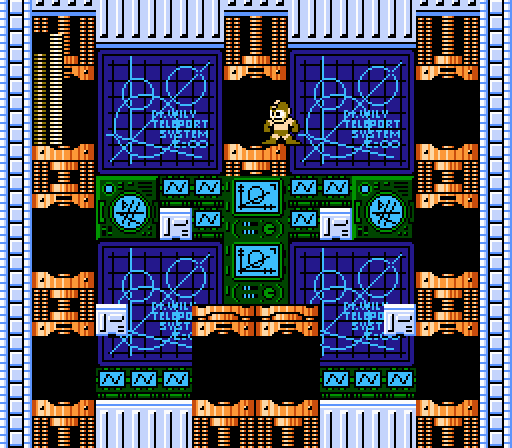
Those screens! In case you ever doubted Mega Man’s anime influence, here are some straight-up Macross computer aesthetics for you to enjoy. I almost expect to see a fusillade of Crash Bombers flying along windy paths or something.
This, of course, is the end game: A showdown with rebuilt versions of Wily’s eight Robot Masters. Mega Man 2 handles this boss rush very differently than the first game did, establishing a fairly permanent standard for the franchise. Rather than spread out the bosses across multiple levels and put the rush at the end of a fairly tricky stage, you fight all eight bosses at once (or rather, one at a time, in rapid succession) in a stage designed specifically to contain the fights.
The basic premise of the rematches remains the same — you warp into a room housing a single boss, defeat it, then exit again to take on the next — but it’s much friendlier this time. The warp chambers are no longer consecutive, so instead of jumping immediately to the next battle you return here to the hub. Even better, each defeated boss drops a large health capsule, so it’s no longer quite such a matter of endurance as in the original. If you die in the process, any bosses you’ve defeated — denoted by the absence of blinking lights on that Robot Master’s telepod — remained destroyed until you hit continue. And, if you’ve made it this far while toting E-Tanks, you’ll still have those going for you until you continue, too. On the other hand, without continuing you also won’t be able to refill your weapons, meaning you won’t be able to use any Crash Bombers here. Not after that Boobeam fight.
And finally, each boss redux battle happens in a plain ol’ empty chamber. No conveyor belt in Metal Man’s room, no uneven flooring in Quick Man and Flash Man’s level. The one exception is that Bubble Man’s room is still flooded, but even then you no longer have to worry about mines lining the ceiling. Unlike in Mega Man, where the lack of Super Arm-compatible boxes in the reduxes could work against you, here the even flooring works more or less universally in your favor. You can stand and pour fire into Flash Man and Quick Man without having to fuss over their unpredictable responses to the varied terrain, and Metal Man… well, now that you have your complete arsenal in hand, you can destroy him in a hilarious two shots of his own weapon. (Or one shot, if you’re playing easy mode.)
There’s a bit of potluck to the enemy order here; the teleporters don’t use the same layout they did in the stage select screen. Heat Man occupies the upper-left corner, not Bubble Man, and there seems to be no correlation between the stage select arrangement and the order of these warp pads. But given how incredibly powerful you’ve become by this point, the fights are enough of a cake walk that it shouldn’t matter; until you learn the layout, you’ll always be on your toes just a bit.
Once the eight Robot Masters are once again reduced to a burst of pulsating circles, a final pad appears.
This, of course, takes you directly to Dr. Wily’s latest personal war machine. This time it’s less like some bizarre upright human torso and more like, I dunno. Slave-1. Wily Machine 2 feels like a deliberate inversion of the previous game’s final machine; its first phase fires beams of energy that travel downward and then curve upward in a parabolic motion, a mirror image of the first machine’s bullets that followed a decaying upward path before plunging down, off-screen.
The second phase, once you take down the outer armor and expose Wily’s inner capsule, is much trickier. It fires beams of energy that travel in a tightly arcing sine wave and can be very difficult to evade. It becomes a battle of attrition, most likely, and if you die against either form of the machine you’re sent back to the first phase on your next attempt.
Wily Machine 2 has two weaknesses, and they seem specifically tailored as a sort of “screw you” from the developers. Atomic Fire, fully charged, will destroy the outer armor in two shots. And both phases are weak to Crash Bomber, with the second form susceptible to taking multiple hits from the sustained explosion. The problem, of course, is that you only really get one chance with these weapons; since the teleportation chamber doesn’t offer you any energy refills when you respawn and the Atomic Fire can only discharge two full-force blasts without needing a refill, the pressure is on not to screw up the second round. And of course you almost certainly have zero Crash Bombers after the Boobeam trap, so the only way to breeze through the battle is to accept a game over and the subsequent energy refill.
But when you do at last destroy Wily Machine 2, the game… isn’t over?
Instead, the floor explodes beneath Mega Man and he plunges into an entirely new stage.
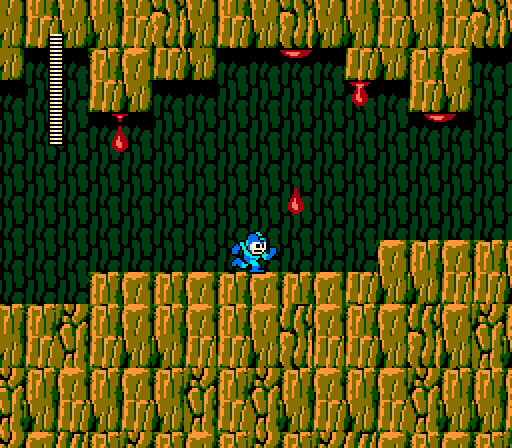
In contrast to the rest of the game, there’s an eerie feel to this sequence. No music plays in the background, and you run through a tunnel bored through pure rock. There are no signs of technology here; no man-made structures, no robots, only silence punctuated by the rhythmic dripping of some sort of caustic fluid.
Finally, you reach a darkened room that appears to be a portal to an alternate dimension, or something. The surreality of this post-Wily sequence reaches its peak as you step into outer space and Wily flies into the room via flying saucer, leaps into the air, and levitates in place as he morphs into his true form…
…an alien!?
The instant he transforms, Wily immediately presses the attack, swooping around the room and firing at Mega Man with single powerful projectiles targeting his location. This fight can only be survived if you keep on the move, avoiding the alien’s flight path and leaping its bullets. You also need to experiment with your weapons, because everything you throw at the alien seems to bounce right off. The only power capable of putting a dent in the alien’s life bar is, almost certainly by design, the last one you’d think to use here: The Bubble Lead.
After all, the alien constantly flies above you, and while the Bubble Lead follows a small upward arc its upward movement is extremely small and ends at about arm’s length before plummeting to the ground. So this introduces an element of risk and space management to an already tense fight; not only do you have to dodge the creature and its deadly fire, you have to do so while daredeviling your way up close to it to fire a Bubble Lead as it reaches one of the low points of its figure-8 movement.
Once you shake off the shock of discovering the truth of Wily’s extraterrestrial origins, the battle turns into an exercise in learning the alien’s pattern and sorting out exactly how you can damage it. Thankfully it follows a consistent pattern of movements and attacks — that Wily, always stuck in the same old patterns and habits — so eventually it just comes down to developing a rhythm and sticking to it long enough to whittle down the alien’s health meter. Naturally, its attacks hit you much harder than yours hit it. On the other hand, you’ll always continue at the beginning of the acid run, so you don’t have to weather the Robot Master/Wily Machine gauntlet again.
And, once the alien is defeated, you discover that you’ve actually been in a sort of planetarium with a projector in the ceiling, and that the “alien” was just a holographic device Wily was directing from a control panel in the corner. Evidently he fully expected all his Robot Masters and his war machines to be defeated and created this weird ruse as a last-ditch measure. Evil geniuses, man. Who even knows.
Cornered, he surrenders, and the game ends for reals as the planetarium projector closes up. Love the way it reflects (refracts?) the pattern on the walls.
And Mega Man goes for a walk, cycling through his powers as he marches forward.
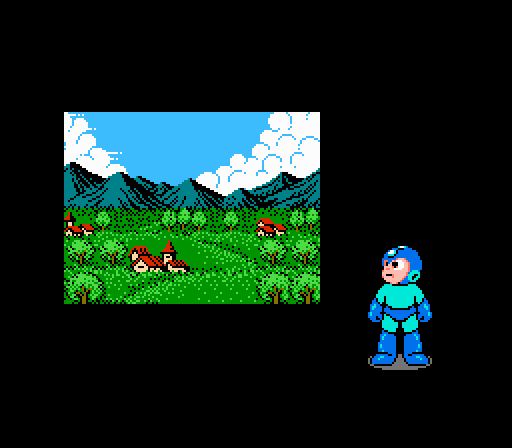
I love the fascinating ambiguity of this sequence. It lacks the sort of triumphant fanfare you’d expect in a game ending, a melancholy tune playing as Mega Man cycles through his powers and the seasons change to reflect his current color scheme. Finally, he reverts to his usual form, and the scene returns to fair weather as well.
He warps out, and the scene expands to reveal that he’s left his helmet behind.
At the time, I took this to represent the end of the series — Mega Man realized he didn’t belong in this world or something and vanished forever. Of course, dozens upon dozens of sequels followed, so I suppose the point was that he realized his newly acquired skills made him too powerful, too dangerous, and this sequence is meant to explain why he always abandons the powers he copies before each new adventure.
It doesn’t matter. The important thing is that it’s a marvelously unique conclusion to a brilliant game, one that improved on its predecessor in every way imaginable and set a new standard for NES software design.
The end.
Next in Anatomy of Games: Super Mario Bros. 2! Ah, but which one…?
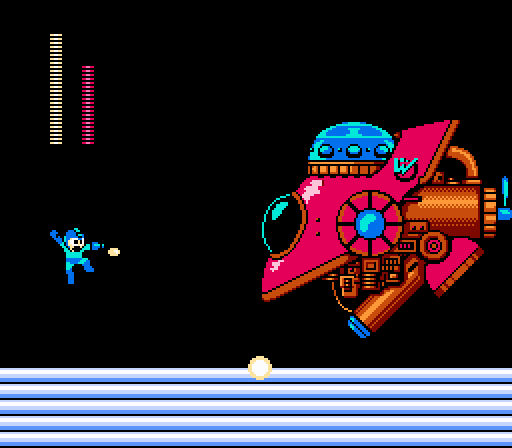
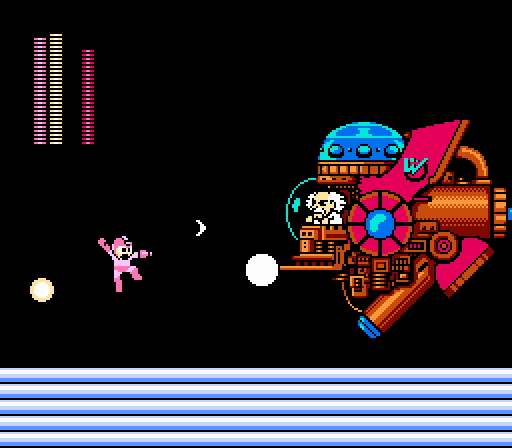

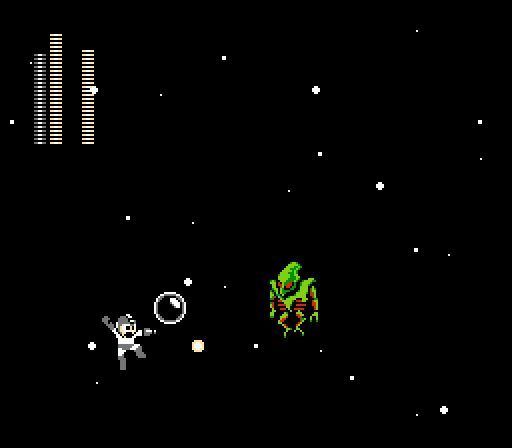

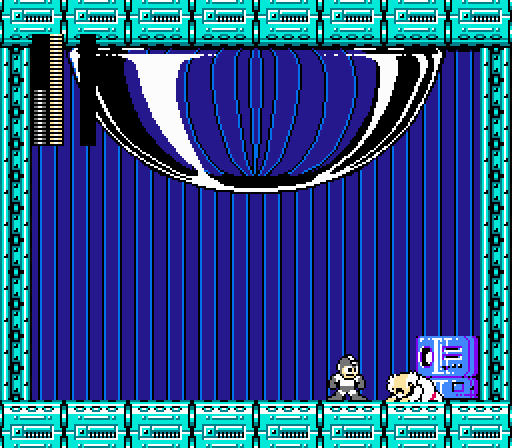

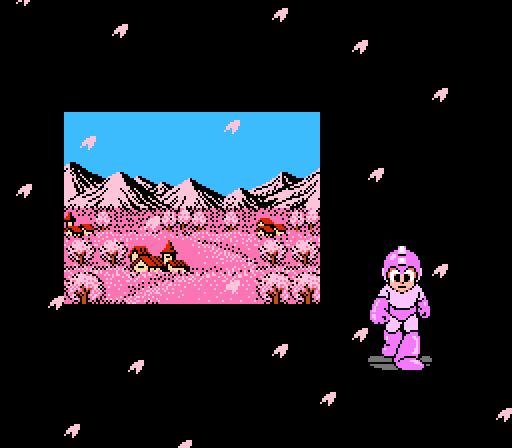

Amazing as always.
I have never commented before, because I was catching up with all the post from the very begining, but I have really enjoyedthis series as well as the Metroid’s anatomies.
Super Mario Bros. 2? I think you’re going for the japneseversion,since is the very true sequel to the first one, and their gameplay is basically the same.
Anyway, I hope you begin the Mother series sometime soon as they’re my favourite series specially Mother 3 which is my favourite game of all time.
Nevertheless, I found this articles very interesting and very well written, keep up the great work!!!
Those screens are pretty cool. I played the game a few weeks ago and got a kick out the text on them. Dr. Wily Teleport System, E = ∞. So simple!! Of course energy equaling infinity is the key to teleporting!
I looked at the ending sequence to be a kind of “you can’t go home after an adventure that big”. I think that’s a literary concept… like in the Lord of the Rings where the hobbits just feel out of place once they get back home at the end. Mega Man looks melancholy as he’s travelling home. He leaves his helmet outside and then travels down the hill to get back to house work for Dr. Light. That’s just how my imagination took it.
I have never comented here before because I was catching up with all the posts from the very beginning but now since you are finished with Megaman 2 I think it’s time.
Since I’m not old enough to have played most of this games when they came out the first time I find this articles very interesting since they give a look on how games where made a while back.
I was lucky enough that my cousin owned a NES back when I was a child so I did have the chance to play Megaman 2 back then and even though it was insanely hard for me as a 5 year old I had a lot of fun with it and still remember some of the stages of the game. I remember the Metal Blade my favourite weapon once I got it since most of the enemies weren’t a problem anymore and also being incredibly shocked when I saw Wily turning into an alien an then seing it was all a facade.
I loved the Metoid write-ups as well since I did played Super Metroid on a SNES and is a incredible game wherever you see it, as well as playing the original Metroid on my Zero Mission cart back when I owned a GBA.
Super Mario Bros. 2? Mmm… I belive you’re going for the japanese version (or Lost Levels, whatever), it’s the real follow-up fkr the first games mechanics, introducing some new stuff (for making your life hell), but that’s just what I think.
I see you’re planning on analizing the Mother series, I hope you don’t wait to long for it since those my very favourite games of all time, specially Mother being the very definition of perfection and all that.
Anyway, I find these articles very fun to read and also very well written so I hope you keep up the good work!!!
Oh…I thought my first comment wasn’t piblished… what the hell.
I meant “Mother 3 being the very definition of perfection and all that”
Mega Man’s facial expression also changes in the walking shots of the ending — in the two you posted, he’s got sort of a flat affect, but in some of them he looks like he’s scowling.
I always read it — and I admit I may be influenced by reading the Worlds of Power novelization before playing the game — as Mega Man throwing off the helmet and going home because that’s where he wants to go; he’d rather not be a warrior, he just wants to be a guy living in a quiet village watching the seasons change. The first and third game’s endings have similar sequences in one way or another.
The X series, of course, made the “I’d rather not be fighting” theory totally unambiguous — or at least laughably inconsistent.
From what I understand, Ian Flynn and Pat Spaziante’s Mega Man comic from Archie also plays a lot with the idea that Mega Man doesn’t really relish going out and shooting other robots, that it’s a duty but not a pleasure and he’d rather just be Rock and hang out at home.
Correcting myself: wrong game. It’s one of the others where he walks toward the camera while alternating between flat affect and scowl. (7, I think?)
I always assumed the ending was just inspired by lots of anime ending sequences where the main character just walks along as scenery scrolls on behind them. And the helmet made me think they were just Nausicaa fans, as that helmet is similar to the Nausicaa ending shot.
Mario 2? What about Goonies 2?
Also, which Mario 2 are you going to do, Japanese one or USA one? Famicom or Mario All Stars? Let me know because I have to get shots for them.
“And Mega Man goes for a walk, cycling through his powers as he marches forward.”
That looks more like walking through the seasons or something. On the other two shots you see Winter (ice) and Rain, which are not powers from the game.
It’s both. The snowflakes look like the Metal Blade and the rain looks like the Time Stopper.
Something about the teleport/hatches chamber that I would like to point out: the hatches are arranged in the order the boss weapons appear in the weapons menu, from top left to bottom right.
The final cave stage is so very jarring compared to not just the rest of the game, but perhaps the rest of the series. There’s nothing else quite like it, with the only area coming close being the final stage in Mega Man 10.
As you have mentioned that MM1 and 3’s ending sequences are somewhat similar, there are also a few similarities between MM2 and MM4’s ending sequences.
This look at Mega Man 2 has been my favorite of the entire Anatomy series. So well done.
As for SMB2, I hope it’s the turnip-tossing one. It’s my favorite of the NES Mario games.
Hah, I somehow never noticed how very Macross the teleport screens are, but you’re totally right!
Couple things I always found interesting about these last two levels:
-I thought it was interesting that Mega Man was the only game in the classic series that spread the bosses out between levels, rather than putting them all in one teleporter room. Then, when the Mega Man X series came along, they did the exact same thing in that series! Mega Man X was the only game in the X series that spread the bosses out, too. I always thought that was a neat throwback.
-Not only is Dr. Wily weak to only the Bubble Lead, but every other weapon HEALS him completely to full health! I remember one time I was messing around and after using up most of my Bubble Lead energy, decided to try other weapons on him. Oops. Bad idea.
The final boss fight has the same problem that the Boobeam trap has, and that’s being weak to one and only one weapon. While you’re less likely to run out of Bubble Lead you still need a considerable amount of it left to win the fight, and if you run out your only option is to commit suicide by Alien Wily or that blood acid stuff until you get a Game Over and the subsequent weapon refill from continuing. The grind spot before the Boobeam trap may have been nasty, but at least it was there.
I’m glad later games more or less got rid of bosses that can only be harmed by a single weapon type. There’s still more optimal killing tools, but at least you’re not completely boned if you run out of your Top Spin or murder bird or whatever.
The only other boss I can think of that is weak to only one weapon is Atetemino, who guards Wily Stage 1 in Mega Man 8. You can only damage him by kicking the Mega Ball at him and he constantly drops containers loaded with weapon energy refills. The Boobeam Trap could have done similar by having every wall and turret drop weapon refills and perhaps Alien Wily could have launched smaller aliens to cause even more trouble but also give you a chance to grind for ammo.
Also, if I remember correctly, your weapon energy refills when you lose a life in Mega Man 8.
I always read the ending as Mega Man walking home (kind of like the ending of Mega Man 1, but flashier). He leaves behind his helmet because the world is at peace so he can go back to being Rock again (until Capcom makes a kajillion sequels anyways :P)
Great series of articles, as always. This brings back so many memories. Mega Man 2 was my introduction to the franchise (after learning about it in none other than Nintendo Power). Mega Man 2 is a game I can consistently start up and play through like an old movie. A true classic. It’s also the first game I ever beat as a child. So it holds that special place for me as well. Looking forward to Mega Man 3.
As far as SMB2…I hope it is the US version as it is the one that brings back the memories since it is the game we grew up with. I also think it would make the best Anatomy since the Japanese game is so similar to the original whereas the US SMB2 is a whole different animal with new mechanics, new stage layouts and new enemies. I think it would make a more interesting piece.
But either way, I’m looking forward to it because you never disappoint.
I think a Lost Levels anatomy would make for a pretty interesting companion piece to the Super Mario Bros. anatomy. Not much has changed in terms of gameplay, but the levels are designed to challenge/troll players who beat the original Super Mario Bros. game.
Basically it’s like a more fleshed out take on The Legend of Zelda’s second quest, but for Mario.
US Super Mario 2 is my favorite, but I can’t help but think that Lost Levels would make a more interesting Anatomy on the whole.
It’s interesting to compare the endings of the first two games with what the developers have said about the circumstances those games were made under. In the first Mega Man, the game that they felt was rushed out too quickly and wasn’t as good as it could be, the ending is basically saying “well, you may have beaten Dr. Wily, but Mega Man’s work is still not done!” Then in the second game, which, more than any other game in the series, was a passion project, and was where they got to do everything they wanted to do in the first game but couldn’t because of time and budget constraints, we get a surprisingly melancholy sequence where Mega Man implicitly retires from being a hero, having accomplished everything he was created to do. It’s almost as if the developers were having Mega Man act out their own feelings about working on the games.
Of course, after that Mega Man became a massive franchise with a ridiculous number of sequels, and if you played Mega Man 3 first, like I did, then by the time you saw 2’s ending, it didn’t make any sense. It still makes for a nice symbolic set of bookends to the game, though, with Mega Man putting on his helmet again at the beginning of the game, and then leaving it behind at the very end.
Another great series of analysis of one of that all time classics. Thanks as always Jeremy.
Sorry to ask here but did anything change recently with the site? In the last few days the images no longer display. I’m viewing the site on a kindle fire HD. Anyone else have this issue?